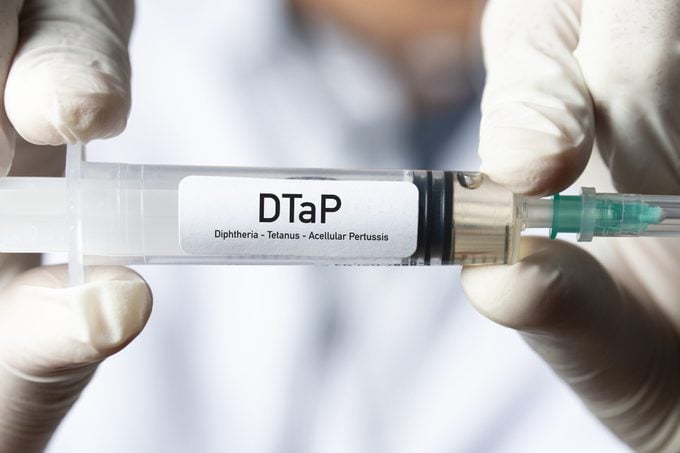7 Things to Know About the DTaP Vaccine for Whooping Cough
Updated: Aug. 21, 2023
Newborns and young children need the DTaP vaccine to avoid these three dangerous diseases: diphtheria, tetanus, and pertussis (aka whooping cough). Here's what you need to know about DTaP vaccination.
What is the DTaP vaccine?
Considering the age you probably got the whooping cough, or pertussis, vaccine, it’s no surprise you don’t remember those shots.
But if you’re a parent, chances are, you remember taking your baby to get the first in a series of DTaP vaccines before they started sleeping through the night.
The DTaP vaccine protects your child from three dangerous diseases: diphtheria, tetanus, and pertussis, the latter of which is also known as whooping cough.
Your child will get it in five doses, the first at 2 months of age and the last between ages 4 and 6, according to the Centers for Disease Control and Prevention (CDC).
Its importance of getting a whooping cough vaccine is hard to overstate, says family medicine specialist Eric Ascher, DO, of Lenox Hill Hospital in New York City. This serious infection can be potentially life-threatening for babies.
“Our best line of defense for prevention of disease and outbreaks is vaccination, and this is especially true with whooping cough, which is really contagious,” says Dr. Ascher.
Here’s everything you need to know about the DTaP vaccine, including what’s in it, potential side effects, and the vaccine schedule.
DTaP is not the same as Tdap
First, let’s clear up any confusion there may be between the DTaP vaccine and another vaccine with a similar name, Tdap.
The Tdap vaccine protects against the same diseases, but it’s used as a booster shot to help maintain disease protection.
Why is it necessary? Although the DTaP vaccine is very effective, the immunity wanes over time.
Doctors recommend that kids get a Tdap booster between ages 11 and 12 and then every 10 years after that through adulthood.
So the Tdap is given to adolescents and adults who need it, including people who are pregnant. (Vaccination during each pregnancy is important to help protect newborns in the window before they can be vaccinated.)
DTaP offers three-in-one protection
When you get the DTaP vaccine, you’re fortifying yourself against three different diseases.
Each poses major health threats, making the vaccine health protective and, in some cases, lifesaving.
Pertussis or whooping cough
All three diseases covered by the DTaP vaccine are serious, but one of them stands out in particular: pertussis.
“In this country, pertussis is the biggest concern of the three,” says John Raimo, MD, chair of medicine at Long Island Jewish Forest Hills in Queens, New York.
“It’s certainly the most contagious of the three,” he says. “The vaccine has been very effective against it, but it is still present.”
Coughing fits caused by pertussis can be so severe, so persistent, and so violent that they can prevent breathing, cause cracked ribs, and lead to hernias. These fits can last 10 weeks or longer.
Dr. Raimo points out that anyone can get pertussis, but newborns are at the highest risk of getting a severe form of the disease.
About half of babies under age 1 who get pertussis end up being hospitalized, says Dr. Raimo, and about a quarter of those will develop pneumonia.
The disease is caused by a toxin released by a bacterium called Bordetella pertussis.
Before the vaccine became widely available in the 1940s, between 100,000 and 200,000 cases occurred per year, according to the CDC. In one year, the number spiked above a quarter million.
Pre-vaccination, whooping cough was one of the most common childhood diseases and a major cause of childhood deaths.
In recent years, thanks to the vaccine, the CDC estimates fewer than 20,000 cases of whooping cough occur in the United States each year. But severe outbreaks still occur. In 2012, for example, there were nearly 50,000 cases in the United States.
Tetanus
Caused by a bacterium called Clostridium tetani, tetanus is not contagious.
Instead, it enters your body through cuts or other wounds, such as stepping on a contaminated nail and puncturing the skin on your foot.
“Tetanus is extremely, extremely dangerous,” says Dr. Ascher. “It can cause muscle stiffening and tightness, seizures, difficulty breathing.”
But the vaccine has made it much less common.
The federal government started tracking tetanus cases in 1947. Since then, the numbers have dropped by 95 percent, and deaths from tetanus declined by 99 percent.
“In the United States, we only see about 30 cases a year because of how well vaccines work,” says Dr. Ascher.
Diphtheria
Before the vaccine, as many as 150,000 cases occurred each year in the United States.
One of the most common and deadliest diseases for children, it killed about one in five children under age 5 who contracted the contagious disease.
These days, fewer than two cases per year are reported.
Like the other two diseases, diphtheria is caused by a bacterium, in this case Corynebacterium diphtheriae.
It hinders both breathing and swallowing, but it also targets the heart, kidneys, and nerves, according to Dr. Ascher.
“Fortunately, because of the vaccination we have and how strongly pediatricians suggest vaccination in a five-shot series, we don’t see diphtheria much anymore, which is great,” he says.

What’s in the DTaP vaccine?
To make the vaccine, scientists inactivate the toxins produced by the different disease-triggering bacteria. That process converts each toxin into what’s called a toxoid.
When the toxoid enters your bloodstream, it triggers an immune reaction and sends antibodies to fight the infection if you ever encounter it. But don’t worry: the toxoid is harmless, so it does not cause the diseases itself.
You get the benefit of training your immune system to fight these infections should you or your child be exposed to them, but no one gets sick. It’s a win-win.
Vaccines used to contain thimerosal, a mercury-based preservative. Although it was safely used for decades, manufacturers removed thimerosal from pretty much all childhood vaccines in 2001 in an abundance of caution.
Vaccines for people of any age are now available in thimerosal-free versions. If a vaccine does contain the preservative, it makes up a vanishingly small amount of the vaccine.
“There’s more mercury involved in getting a filling at the dentist,” says Dr. Ascher. “It’s so minimal in regards to long-term exposure, and we know these vaccines are safe from many long years of using them.”
The DTaP vaccine does not put brain health at risk
Dr. Raimo dispels another concern he hears occasionally: that the whooping cough vaccine puts your brain health at risk. Not so, he says.
“There was concern about a very rare form of brain injury, which at the time was being called pertussis vaccine encephalopathy,” he explains. “It was seen in about one in every 300,000 patients.”
The vaccine was studied further to determine whether there was, in fact, a connection.
“Later studies showed that there was really no connection between the vaccine and the brain injury, which was later shown to be an unrelated form of epilepsy,” he says. “But you do still see people bring it up from time to time.”
If that’s not enough to put concerns to rest, consider this: when those alarm bells sounded in the 1970s and 1980s, says Dr. Raimo, another form of the vaccine was in use.
“Even had there been a connection, which there wasn’t, the vaccine is different now anyway,” he says.
And it bears repeating that vaccines do not cause autism—the theory has been thoroughly debunked after decades of intensive study. Groups like the CDC, the American Academy of Pediatrics, and advocacy groups like Autism Speaks all strongly state that there is no link between the two.
Possible side effects of the DTaP Vaccine
Both Drs. Ascher and Raimo tell their patients to expect soreness and redness at the injection site, though those won’t occur in everyone. Other side effects are quite uncommon.
“Fatigue and a low-grade fever are possible but very rare,” says Dr. Ascher.
Also rare: allergic reactions to the vaccine. But you’ll want to tell your doctor if your child has had a reaction to a previous vaccine, says Dr. Ascher.
Your child will be monitored for up to 30 minutes after the shot to be sure that no serious side effects occur.
“It’s important to remember that any time there’s a side effect or your body feels a little bit different after getting the vaccine, that’s just your body’s way of showing that the vaccine is starting to work,” says Dr. Ascher. “Your body is picking up this immune response to protect you.”
Each of the vaccine components has different potential side effects:
Diphtheria
Pain or soreness at the injection site. A low-grade fever is also possible.
Tetanus
Pain or soreness at the injection site.
A low-grade fever is also possible. Severe allergic reactions, such as hives, difficulty breathing, or a drop in blood pressure, occur in about one in a million children.
Such reactions can be treated in the doctor’s office with an injection of epinephrine (an EpiPen), explains Dr. Ascher.
Pertussis
About a third of children develop mild side effects, such as pain and tenderness at the injection site, but this usually occurs after the fourth or fifth dose.
More-severe reactions, which occur in one in 10,000 children, include a high fever, seizures resulting from the fever, and inconsolable crying, as well as listlessness and lethargy with poor muscle tone, lasting several hours.
DTaP vaccine schedule and immunity
Here’s the recommended schedule for the five dose series, according to the CDC:
First dose: 2 months old
Second dose: 4 months old
Third dose: 6 months old
Fourth dose: 15 to 18 months old
Fifth dose: 4 to 6 years old
Parents should take their children for their first Tdap vaccine at age 11 or 12.
People who are pregnant should get a Tdap booster in their third trimester. As we mentioned, this is to ensure the mother passes on the antibodies to her newborn until the child is able to receive the first dose of DTaP at 2 months old.
Everyone should get the Tdap vaccine every 10 years after that, according to Dr. Raimo and Dr. Ascher.
“The general guideline is to get a booster every ten years because you don’t know if your immunity is waning without a blood test,” explains Linda Yancey, MD, an infectious diseases specialist at Memorial Hermann Hospital. “There are titers that can be run to test for immunity but they are harder to find and more expensive than the shot itself. It is far easier just to get the shot. If you’re not sure when your last shot was, err on the safe side and get one. There is no harm in getting vaccines less than 10 years apart. You could safely get one a year, every year.”
(Don’t miss the other pertussis precautions you can also take.)
The importance of getting vaccinated
The DTaP vaccine is intended for use only among infants and children, with infants receiving their first dose at 2 months.
This is not to be confused with the one-shot booster Tdap, which offers protection against the three diseases for those age 11 and older.
Vaccination is important to reduce the spread of contagious diseases like whooping cough and to prevent serious disease and even death.
Next, here are the pertussis treatments to know about in case you or your child get infected.














